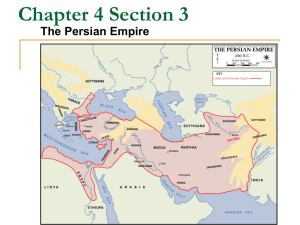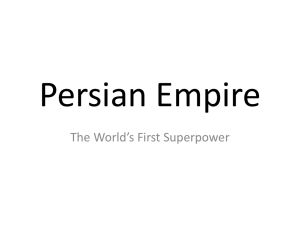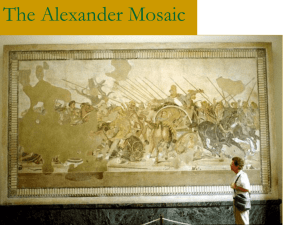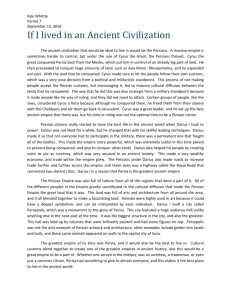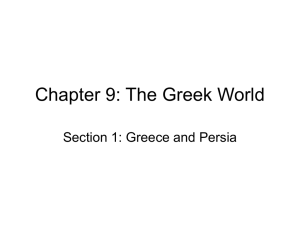Gallery 1
advertisement
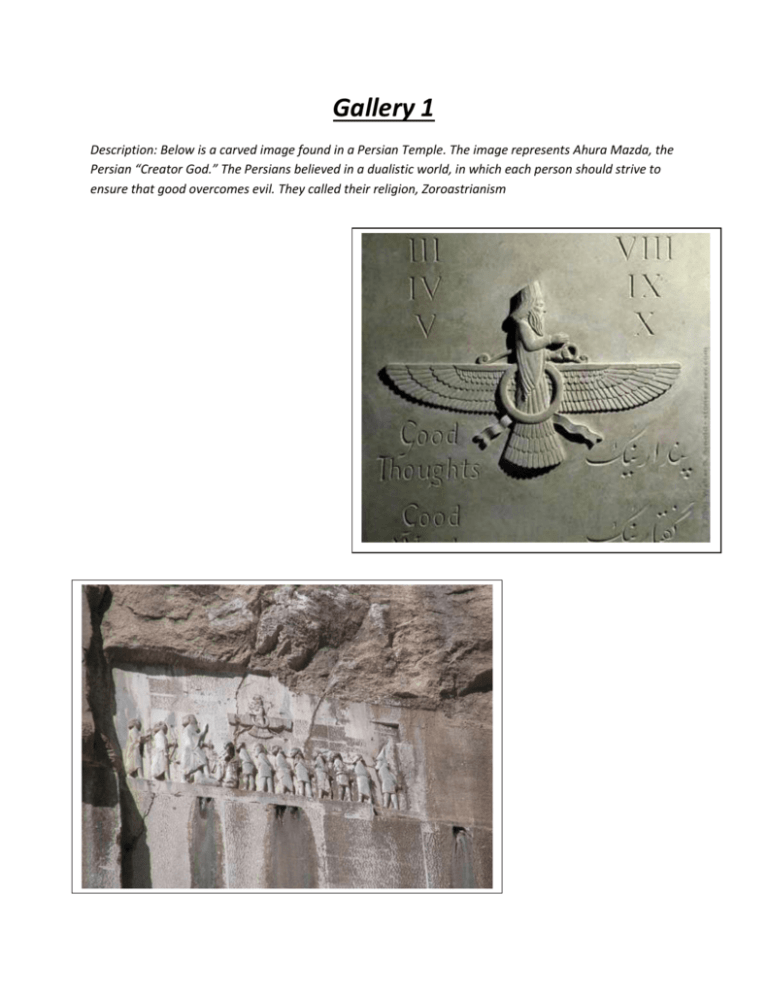
Gallery 1 Description: Below is a carved image found in a Persian Temple. The image represents Ahura Mazda, the Persian “Creator God.” The Persians believed in a dualistic world, in which each person should strive to ensure that good overcomes evil. They called their religion, Zoroastrianism Gallery 2 Description: Although the Western Wall is all that is left, we know that this is what the second temple of the Hebrews looked like. King Nebuchadnezzar exiled the Jews because of their Monotheistic religion, however, Cyrus the Great, the first Persian Emperor allows them to return to Jerusalem. Cyrus the Great allows the Hebrews to re-build their temple. Description: On the Cyrus Cylinder below, Cyrus The Great, the first King of the Persian Emperor, details how he conquered the Chaldeans, and announced a number of reforms that he made after conquering the country. These include arranging for the restoration of temples and organizing the return to their homelands of a number of people who had been held in Babylonia by the Babylonian kings. For these reasons the cylinder, known as Cyrus Cylinder, has been called the earliest known document in the history of religious toleration. It is preserved in the British Museum. Gallery 3 Description – Below is an image of a carving found in modern day Iran, which was once the Persian Empire. It is a brief autobiography of Darius I, including his ancestry, lineage etc. Later in the inscription, Darius provides a lengthy sequence of events following the death of Cyrus the Great and Cambyses II. The inscription includes three versions of the same text, written in three different cuneiform script languages: Old Persian, Elamite, and Babylonian. In effect, then, the inscription is to cuneiform what the Rosetta Stone is to Egyptian hieroglyphs: the document most crucial in the decipherment of a previously lost script. "Translation of the text was a multi-step and multi-national effort based on earlier work done on the decipherment of the Old Persian script. It took almost over 50 years to finally translate the stone. The Inscription is 100 meters up a limestone cliff from an ancient road connecting the capitals of Babylonia and Media. The Old Persian text contains 414 lines in five columns; the Elamite text includes 593 lines in eight columns, and the Babylonian text is in 112 lines. The inscription was illustrated by a lifesized bas-relief of Darius I, the Great, holding a bow as a sign of kingship, with his left foot on the chest of a figure lying on his back before him. Darius is attended to the left by two servants, and ten one-meter figures stand to the right, with hands tied and rope around their necks, representing conquered peoples. The Persian God floats above, giving his blessing to the king. Gallery 4 Description: By 484-425 BCE, the Persian Royal Road ran some 2,857 km from the city of Susa on the lower Tigris to the port of Smyrna (modern Izmir in Turkey) on the Aegean Sea. A highway built by the Persian king of kings Darius I to facilitate rapid communication and intelligence gathering throughout the Persian Empire. The Royal Road was protected by Persian rulers and later used by the Romans. On this road couriers, riding in relays, could travel 1,677 miles (2,699 km) in seven or nine days. Herodotus wrote: “There is nothing that travels faster, and yet is mortal, than these couriers; the Persians invented this system, which works as follows. It is said that there are as many horses and men posted at intervals as there are days required for the entire journey, so that one horse and one man are assigned to each day. And neither snow nor rain nor heat nor dark of night keeps them from completing their appointed course as swiftly as possible. The first courier passes on the instructions to the second, the second to the third, and from there they are transmitted from one to another all the way through, just as the torch bearing relay is celebrated by the Hellenes in honor of Hephaistos. “ Name:_________________________________ Block:______________ Gallery Walk Questions Gallery 1: 1. The Persians carved images of their God into many pieces of artwork. What does this tell you about their religious fervor? 2. The second image shows a victory of one of the Persian Kings. Above the king is the Persian God, granting His blessing over the victory. What does this tell you about Persian beliefs? Gallery 2: 1. Cyrus the Great allowed the Jews to return to Jerusalem, and freely practice their religion. Why do you think this example of TOLERANCE allowed Cyrus to be such a successful ruler? 2. Why is the Cyrus Cylinder so important to understanding the Persian Empire? Gallery 3: 1. Why is the carving found in Iran so important to understanding Persian, and other Middle Eastern civilizations, traditions? 2. What does this image tell you about how citizens of Persia felt about Darius I? Gallery 4: 1. How do you think the Royal Road helped Persia to prosper? 2. Why do you think Darius I felt compelled to build the Royal Road?


